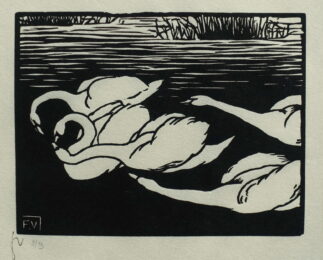


Les Nabis (from the French “le nabi”) was a young collective of French artists active in Paris between 1888 and 1900. Fresh, dynamic and keen to challenge traditional artistic notions, they played a substantial part in the transition from academic art and impressionism to symbolism, abstract art and many other early modern art movements. Members of the original group included Maurice Denis, Édouard Vuillard, Pierre Bonnard, Paul Ranson, Félix Vallotton, Ker-Xavier Roussel and Paul Sérusier. Most of them were students in the late 1880s at Paris’ Académie Julian.
In October 1888 Paul Sérusier had travelled to Pont-Aven, and guided by Paul Gauguin, he created a small painting of the port on wood. It was composed of areas of vivid colour, elegantly worked together to encapsulate the essence of the port and its atmosphere. The group named this inaugural Nabis piece “The Talisman” and in time it went on to became one of the most famous pieces of 20th century art.
Les Nabis artists shared a common appreciation for the work of Paul Cézanne and Paul Gauguin and were driven by a desire to renew the art of painting. However, each artist varied noticeably in their unique and individual style. The group believed that works of art should not merely depict nature, but instead should work in harmony as a collective of symbols and metaphors conjured up by the artists themselves.
The name “Les Nabis” originally comes from the Arabic word “nabi” – meaning prophet – as well as the similar word “nebiim” in Hebrew. The term was initially used by linguist Auguste Cazalis, who noted a parallel between the way these artists aimed to revitalise painting (as leaders in modern art) and the way in which the ancient prophets had reinvigorated Israel.
Heavily influenced by the music, literature and theatre of the symbolist movement, the Nabis were somewhat enigmatic and esoteric in nature. Progressive and reformist in their approaches, they turned their backs on the materialistic demands of the new industrial age, and were instead consumed by the poetry of Mallarmé, Edgar Allan Poe and Baudelaire. They were vehemently opposed to the undercurrent of naturalism prevalent in the paintings of Manet and Courbet, as well as in the literature of Émile Zola.
One of the group’s most common subjects was of women in an idyllic environment such as a garden setting, often picking fruit or flowers. They were also concerned with religious works, with Maurice Denis often painting themes and depictions taken from the Bible, but with the figures in simplified landscapes and modern costumes, bathed in light – a symbol of faith.
Essentially, the Nabis had a number of key objectives but the main one was in breaking down the barriers between art and everyday life, particularly with regard to the relationship between art and decoration. They designed murals, tapestries, screens, wallpaper, lampshades, dishware, furniture and ornaments, as well as costume design, theatre décor and graphic design for advertising. Indeed, a sizeable number of their artworks were designed specifically to be decorative so it could be displayed in dining rooms and salons, and many limited edition prints are still highly collectable today.